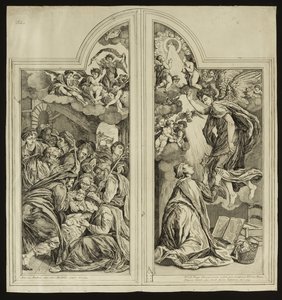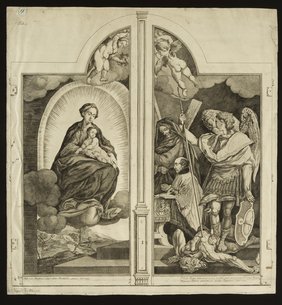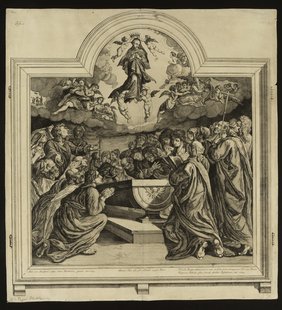In a series of three large-format etchings, the Dutchman Paul Constantin La Fargue (1692–1779) documented five panels of a winged altarpiece created in Utrecht in 1579 by Anthonie Blocklandt van Monfoort (c. 1533–1583). At the time of the reproduction in 1759, the work was in The Hague in the possession of the jurist Johannes Jacobus van Reenen, who had commissioned La Fargue to create the series.
The three sheets present, on the one hand, the central panel of the altar with the Assumption of Mary, and on the other hand, the two wings, each in an open and closed state. The reverse sides of the wings show Mary with the Child in the clouds on the left and Saint Andrew, the Archangel Michael with Satan wrestled to the ground, and the kneeling donor Gerrit Anthonis van der Gou (d. 1573) in the choir robe on the right.
The depictions of the Annunciation and the Adoration of the Shepherds, which in the original flank the Assumption, i. e. show the open state, have swapped sides in the etching. Thus the Adoration is reproduced on the left, the Annunciation on the right, which again results in the concise frame shape of the central panel with the round arch ending above the central axis.
The precision with which La Fargue reproduces not only the frame of the painting but also its moulding, brackets, hinges, screws and even the keyhole is remarkable. The intention of the commissioner and the artist to not only transfer Blocklandt's invention into the print here, but to document the object itself, is confirmed in the inscriptions that, in addition to the painter and the date of creation, also name the dimensions of the altarpieces as well as the owner and commissioner of the prints at the time. An important aspect that the etchings could not convey, however, was the colouring of the painting. Thus it can be assumed that when La Fargue turned his attention to the object again, he did so in order to take account of the colour this time: the Rijksmuseum in Amsterdam (RP-T-00-1851) preserves three oil drawings of the central panel and the open wings, which La Fargue ("Door P. C. La Fargue gecoulerd An.o 1772. Conform 't Origineel.") also made on van Reenen's commission in 1772 and whose colouring - insofar as a comparison of illustrations permits - quite matches the original triptych by Anthonie Blocklandt now in the Bingen parish church of St. Martin.
br




